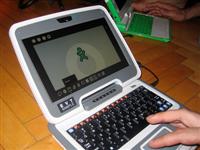L. Aaron Kaplan is the founder and an active member of OLPC Austria, where he has, among other projects, ported Sugar to the original Classmate PC.
Finally, finally, finally!! I and a few folks have been living with a secret. And of course I wanted to share this as soon as possible. But some events at work (the famous DNS Bug) kept me massively busy. And since work is - well work - you earn a living from it - it got priority. However this nonetheless does not make the secret any less important nor interesting.
So, what is it about? What's it about? Hm, let's think... the title says "sugarize it". Sugarize what?
As you probably know, sugarlabs.org became independent from OLPC with Walter Bender starting a new organization to continue the dream of an open source user interface for OLPC and for other laptops.
I have been already "ported" Sugar to the Intel Classmate 1. Back then I was quite disappointed with Intel. I did not do any precise tests but it just felt s.l.o.w.
Also Wayan was ranting against the Classmate 1. I agree - the version 1 was not particularly competitive against the XO in my opinion. But is the Classmate 2?
(tada, enter the culprit...)
So, well... now I received a Classmate 2 with Atom chipset (no, you can't get them yet as far as I know, but you will soon be able to get one for sure). Actually - the fact the you will indeed be able to get them will already be a remarkable difference compared to OLPC's "you can look but not buy" marketing.
Not only did I get a Classmate 2 from Intel, they were even happy to supply one! This was almost a shock for me - compared to the constant pushing I had to do at OLPC's doors to be allowed to contribute and to be granted some resources. Way to go Intel!
So - again - what can we do with that brand new sample version of the Classmate 2 (Atom based)? Can it compete with the XO? Is the CPU really finally fast and power aware at 2.5 Watts? Uhum...
Sugarizing the Classmate 2
Since the Classmate came already with Ubuntu 7.10 installed, we had to update it to 8.04 over the wifi network. Wait! Did I just write "over the wifi network"? Yes, actually that worked out of the box. So, some 45 minutes later all packages had downloaded and were installed.
The next step was to install Sugar. One way would be to use a Live CD which in in general is well maintained. We instead chose to install Sugar directly as Debian packages. We simply followed the wiki pages and found that the packages were not 100% up to date. We could have re-build everything from scratch using jhbuild but according to Daniel this would have taken a long time to build. So, we decided to live with the fact that in the version we tried the browse activity did not work correctly. For sure a more recent version will fix this.
Summary: installing Sugar on the Classmate is rather easy. Just follow the instructions.
So! How does it look like? Does everything work?
Camera: Works. Has a pretty decent resolution. Enough for kids to take pictures of things and share it over the network.
Sleep mode: Works. Some minor issues on resume.
Keyboard: Usable. Still a bit small but you get used to it.
Trackpad: Usable. Could be improved with better driver support so that scrolling works better.
Screen resolution: 1024x600 - usable. I miss the reflective display. There are still some minor bugs with placement of objects in Sugar. Supposedly fixed in newer releases.
Wifi: Yup! works out of the box. Currently some issues with resuming after sleep mode. Can be fixed.
OpenGL: Yup, you bet! Glxgears runs in 580 frames / sec. Totally smooth. Great! All OpenGL linux games run great. Tuxracer, GCompris, all there..
Sound: Works ok
Microphone: Fine!
Skype: Works. Nice to have a faster CPU than the XO
Flash: Of course it works if you have space for a full blown Redhat or Ubuntu as basis below it. Didn't bother to install gnash. This means....
YouTube: Works! This is one killer feature for deployment in classrooms. Believe it or not, but Andreas Trawoeger has been brave to test out the features of the XO (and other computers) in a school in Vienna for half a year now. And this was one of the feature he bitterly missed on the XO. Kids love watching things on YouTube and uploading stuff to the site.
Google Earth: Well, Google Earth was a bit CPU and memory hungry. That one started to get a bit slow.
Overall Speed: Needless to say, 1.6GHz is actually really usable for most things in a classroom.
Green ears: No :(
Battery life: Well, medium. I got 3-4 hours out of it. I guess more is doable with proper ACPI support. I guess you can do more with proper tuning.
Price: >188 USD. Approximately 315 Euros in the EU. That is definitely higher. Does it pay off? Yes.
Collaboration? Mesh?
Yes, you bet! Collaboration between an XO, the Classmate 2 and an HP 2133 worked out of the box. To be fair, we had a wireless access point in between the three devices since OLPC's 802.11s and Intel's 802.11s won't work together out of the box right now. Sigh, I guess that is why we have standards. Hmmm... did you get the head fake? I will leave you to ponder about it.
Subjective summary:
Well, the good and cosy feeling of "helping the world" is not present anymore. The green ears are missing, the sweetness factor is gone.
... But.. Hey! On the other hand: this small device is for the first time totally usable! It is fast, compared to the others. There is a dramatic speed improvement compared to the Classmate 1. Would I buy the Classmate 1 for kids? No. Would I buy the Classmate 2? Yes.
A friend of mine forgot his laptop at home and he was at my place over the weekend. We had an intensive planning session, lots of research on the web. And since he forgot his laptop at home, he used the Classmate 2. His conclusion? "Totally usable. A bit small for adults." But fast enough.
So everything works more or less out of the box! If you have small fingers it might even be usable for adults. Your kids will not look at it and sigh love it and then leave it in a corner. But they will love it because they can actually do things with it. Like adults. I believe what counts is to give kids the possibility to access information that they would not otherwise get access to. With usable tech. Whatever brand. It's an education project, not a laptop project. Right?
Well done Intel! Congratulations. Credits where credits are due. The Classmate 2 is a solid product! The wikipedia entry of the Classmate will have to be rewritten for the Classmate 2.
Tests by: Daniel Jahre, Helga Schmidt, Andreas Trawoeger, Tano Bojankin, L. Aaron Kaplan @ OLPC (Austria)
Text by: L. Aaron Kaplan







>>> Well, the good and cosy feeling of "helping the world" is not present anymore.
I still get that feeling with the work that Walter Bender and his crew put into Sugar and the related software. Isn't that what this is all about? :)
Good review of the technology + capabilities.
315 Euro is $463 -- this is about the same price as a similar general-purpose laptop, or almost two and a half XOs. Does it provide any advantages for use in schools over Asus, Dell or MSI small laptops? Are we back to the "constant price, climbing specs" model of hardware development and production that will keep laptops expensive forever?
well, no. I don't know the price politics of Intel. You have to consider that for hardware, EURO prices == Dollar prices at the moment (this is due to custom duties, compulsory warranty etc in the EU).
AFAIK Intel does plan to also have larger numbers and drive the price down. However that also offer support, planing, training etc for teachers. That is a big difference.
Concerning the pricing: I believe the XO already pushed down the prices pretty much. Take a look at Elonex One, Asus etc. That is one of the great (indirect) effects of OLPC. And since we already have that cheap laptop market, Intel will hardly be able to suddenly raise the price. Just my opinion of course...
Aaron, this is a great breakthrough. This will only be meaningful when there are clear and simple instructions somewhere that parents and teachers can follow. Will your installation work on the 2goPC, which is the Classmate 2 with a Celeron processor? I bought a 2goPC off Amazon recently, and am looking forward to testing Sugar on it.
Mike,
Fedora, Debian, and Ubuntu are all working on getting the latest Sugar packages into their distributions.
FLOSS Manuals, OLPC, and Sugar Labs are getting together next week to update and rewrite http://en.flossmanuals.net/OLPC_simple .
Those should help reduce some of the barriers to entry for adopting Sugar.
> To be fair, we had a wireless access point in between the three devices since
> OLPC's 802.11s and Intel's 802.11s won't work together out of the box right now.
OLPC-to-OLPC mesh barely works at all (due to a variety of reasons mentioned on
devel@laptop.org), so this is not any way a loss.
@teapot: "Are we back to the "constant price, climbing specs" model of hardware development and production that will keep laptops expensive forever?"
That is certainly Intel's strategy. That's because it makes its money selling high-end, high-margin cpu's. XO instead is going to pick with the minimum specs needed for a workable laptop, and keep reducing the price.
Focus, focus, focus - though I applaud wider adoption of Sugar. Lets get Sugar as right as possible, running on the Fedora base, and then start spreading around other Linux variant bases. It seems the Fedora folks are fully/truly open about all they do, and it would not be hard to adopt to Debian and others later.
But I am concerned with folks spending time worrying about the multiple Linux-flavor turf, when MS is beating down to try and get govt's to request Windows XP. Sugar is a unique opportunity to create a new UI, targeted at young kids - the first time in the last 20 years to have a non WIndows or Apple UI, become widespread.
I would suggest people focus on getting Sugar on Fedora-base doing great, and then eventually get running on multiple Linux variants.
@Bass Fisher:
"I would suggest people focus on getting Sugar on Fedora-base doing great, and then eventually get running on multiple Linux variants."
I completely disagree. Ubuntu development is very strong on the Linux desktop "market". They have the knowledge and experience to improve all aspects of Sugar.
In the software market, it is the number of developers that ultimately counts (and the number of managers on the downside). If Sugar is available on more distributions, it will develop much faster.
Winter
IMHO Sugar should be made available on as many distributions and devices as possible. And looking at some of the current discussions on the its-an-education-project mailing-list we certainly seem to be moving into that direction. :-)
independent, not independant.
Corrected.